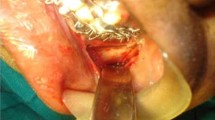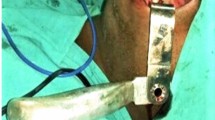Abstract
With expanding dimensions and an eminent member of trauma team many Ear Nose Throat specialists are exposed to Oro-maxillofacial trauma. Mandibular angle is a difficult region to operate owing to its unique anatomy. Anglefractures form around 30–40% of the mandibular fracture. Open reduction and internal plating is the management of choice in most angle fractures and various approaches have been described in literature. We conducted a study of trans-buccal approach for management of mandibular angle fractures. It was a non-randomised observational study. 57 patients of mandible angle fractures were included in the study. The ORIF was done in these pts under general anaesthesia after careful surgical planning using trans-buccal approach. This approach included an intraoral exposure with stab incision for the trans-buccal passage of drill and screw diver. Out of 57 cases in our study 33 were males and 24 were females. 23/57 patients were in age group 25–35 years whereas 19/57 patients were in age group 15–25 years All 57 patients had good fracture healing. Occlusion dysfunction was seen in only 1 case. Infection was seen 3 cases while intraoral exposure of plates occurred in 2 cases. Average mouth opening was 43.3 mm at 6 weeks with progressive improvement on follow up. Extraoral scar healed well with very good cosmesis in all cases. We strongly suggest the use of transbuccal approach for ORIF in mandibular angle fractures owing to the ease of procedure, comfort of surgeon and less complication rate.






Similar content being viewed by others
References
Haug RH, Prather J, Indresano AT (1990) An epidemiologic survey of facial fractures and concomitant injuries. J Oral Maxillofac Surg 48:926–932
Schubert W, Kobienia BJ, Pollock RA (1997) Cross-sectional area of the mandible. J Oral Maxillofac Surg 55:689–693
Dodson TB (2004) Third molars may double the risk of an angle fracture of the mandible. Evid Based Dent 5(3):78
Reitzik M, Lownie JF, Cleaton-jones P, Austin J (1978) Exper- imental fractures of monkey mandibles. Int J Oral Surg 7:100–103
Gear AJ, Apasova E, Schmitz JP, Schubert W (2005) Treatment modalities for mandibular angle fractures. J Oral Maxillofac Surg 63:655–663
Fonseca RJ, Walter RV (1997) 2nd ed, vol 1, Pennsylvania, W. B. Saunders Company, Oral and Maxillofacial Trauma, pp 474–478
Devireddy SK, Kishore Kumar RV, Gali R, Kanubaddy SR, Dasari MR, Akheel M (2014) Transoral versus extraoral approach for mandibular angle fractures: a comparative study. Indian J Plast Surg 47(3):354–361. https://doi.org/10.4103/0970-0358.146590. PMID: 25593420; PMCID: PMC4292112
Dierks EJ (1987) Transoral approach to fractures of the mandible. Laryngoscope 97:4–6
Raveh J, Vuillemin T, Lädrach K, Roux M, Sutter F (1987) Plate osteosynthesis of 367 mandibular fractures: the unrestricted indication for the intraoral approach. J Craniomaxillofac Surg 15:244–253
Toma VS, Mathog RH, Toma RS, Meleca RJ (2003) Transoral versusextra-oral reduction of mandible fractures: a comparison ofcomplication rates and other factors. Otolaryngol Head Neck Surg 128(2):215–219
Kale TP, Baliga SD, Ahuja N, Kotrashetti SM (2010) A comparative study between transbuccal and extra-oral approaches in treatment of mandibular fractures. J Maxillofac Oral Surg 9(1):9–12. https://doi.org/10.1007/s12663-010-0026-7. Epub 2010 Jun 4. PMID: 23139558; PMCID: PMC3453684
Gupta M, Bhagol A (2011) Is a single miniplate at the inferior border adequate in the management of an angle fracture of the mandible? Otolaryngol Head Neck Surg 145(2):213–216
Iizuka T, Lindqvist C, Hallikainen D, Paukku P (1991) Infection after rigid internal fixation of mandibular fractures: a clinical and radiologic study. J Oral Maxillofac Surg 49:585–593
Al-Moraissi EA, Ellis E III (2014) What method for management of unilateral mandibular angle fractures has the lowest rate of postoperative complications? A systematic review and meta-analysis. J Oral Maxillofac Surg 72(11):2197–2211
Sugar A, Gibbons A, Atton D et al (2009) A randomised controlled trial comparing fixation of mandibular angle fractures with a single miniplate placed either transbuccally and intra-orally, or intra- orally alone. Int J Oral Maxillofac Surg 38:241–245
Kumar S, Prabhakar V, Rao K, Brar R (2011) A comparative review of treatment of 80 mandibular angle fracture fixation with miniplates using three different techniques. Indian J Otolaryngol Head Neck Surg 63(2):190–192. https://doi.org/10.1007/s12070-011-0236-4. Epub 2011 Apr 11. PMID: 22468259; PMCID: PMC3102161
Laverick S, Siddappa P, Wong H et al (2012) Intraoral external oblique ridge compared with transbuccal lateral cortical plate fixation for the treatment of fractures of the mandibular angle: prospec- tive randomised trial. Br J Oral Maxillofac Surg 50:344–349
Wan KA, Williamson RA, Gebauer D, Hird K (2012) Open reduction and internal fixation of mandibular angle fractures: does the transbuc- cal technique produce fewer complications after treatment than the transoral technique? J Oral Maxillofac Surg 70(11):2620–2628
Pattar P, Shetty S, Degala S (2014) A prospective study on management of mandibular angle fracture. J Maxillofac Oral Surg. https://doi.org/10.1007/s12663-013-0542-3
Ellis E III (2009) Management of fractures through the angle of the mandible. Oral Maxillofacial Surg Clin North Am 21(2):163–174
Kuriakose MA, Fardy M, Sirikumara M et al (1996) A comparative review of 266 mandibular fractures with internal fixation usingrigid (AO/ASIF) plates or mini-plates. Br J Oral Maxillofac Surg 34(4):315–321
Khandeparker PVS, Dhupar V, Khandeparker RVS et al (2016) Transbuccal versus transoral approach for management of mandibular angle fractures: a prospective, clinical and radiographic study. J Korean Assoc Oral Maxillofac Surg 42:144–150
Author information
Authors and Affiliations
Corresponding author
Ethics declarations
Conflict of interest
The authors declare that they have no conflict of interest.
Ethical Approval
Before starting the study ethical clearance was taken from institutional ethical committee as per Declaration of Helsinki.
Informed Consent
Informed consent was taken by all the patients before surgery and enrolment into the study.
Additional information
Publisher's Note
Springer Nature remains neutral with regard to jurisdictional claims in published maps and institutional affiliations.
Rights and permissions
About this article
Cite this article
Bhardwaj, B., Singh, J. & Mahajan, S. Transbuccal Approach in Management of Mandible Angle Fracture. Indian J Otolaryngol Head Neck Surg 72, 457–462 (2020). https://doi.org/10.1007/s12070-020-01904-y
Received:
Accepted:
Published:
Issue Date:
DOI: https://doi.org/10.1007/s12070-020-01904-y




